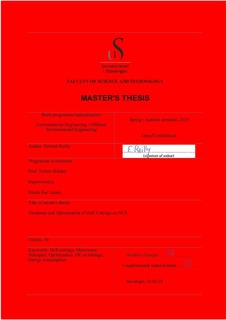| dc.description.abstract | As part of a Joint industry project (JIP), Norwegian Technology has developed a new treatment technology for oil contaminated drill cuttings (OCDC). The technology is intended for offshore use at the Norwegian Continental Shelf (NCS). In order to allow for offshore treatment and onsite discharge, the drill cuttings need to meet requirements set by the Norwegian Environment Agency. According to the Oslo Paris commission (OSPAR), the maximum oil content on drill cuttings should be below 1 wt% and for the Norwegian Environment Agency a maximum oil content on drill cuttings varies but is often below 0,5 wt%.
In this research, the objective was to investigate and optimize the technology for the waste stream received by ConocoPhillips as part of the Joint industry project. Furthermore, various oil contaminated drill cuttings from the Norwegian Continental Shelf were tested, in order to evaluate the technology for drilling waste on NCS. In addition to this laboratory research, the results were combined with accessible full-scale microwave treated data, in order to predict a realistic scaleup.
The results of the optimized tests received from Eurofins were 0,51 wt% oil on cuttings (OOC) for ConocoPhillips 17-inch, 0,53 wt% OOC for ConocoPhillips 16X-inch, 0,44 wt% OOC for ConocoPhillips 16Y-inch and 0,07 wt% OOC for Equinor.
These result was optimized with respect to energy consumption in relation to oil separation. The energy consumption for ConocoPhillips 17-inch was reduced by 23 % while achieving 0,51 wt% OOC. ConocoPhillips 16X-inch was reduced by 20 % in energy consumption while achieving 0,53 wt% OOC. ConocoPhillips 16Y-inch was reduced by 12 % in energy consumption while achieving 0,44 wt% OOC. Equinor was reduced by 16 % in energy consumption while achieving 0,07 wt% OOC.
According to existing work found in the literature, a 35-50 % energy decrease for the cuttings is expected when treating the drill cuttings in full-scale. This relates to increased power density and a decrease in microwave frequency. By applying this to the laboratory results it leads to a technology that can reduce oil content to market leading levels, while simultaneously maintaining energy efficiency.
Testing of ConocoPhillips 17-inch drill cuttings was done with a fellow student, Bernt-Helge Vedeld Nygård. | nb_NO |

